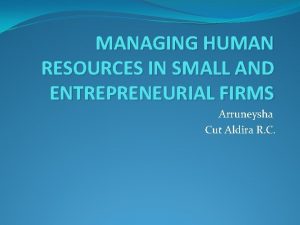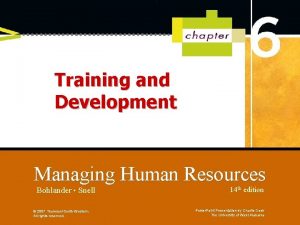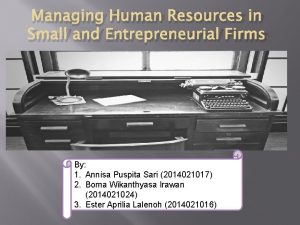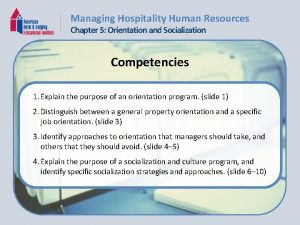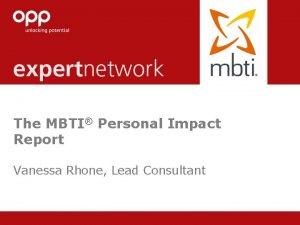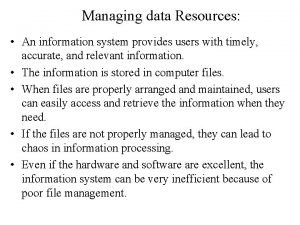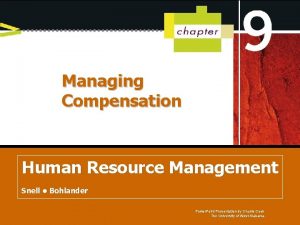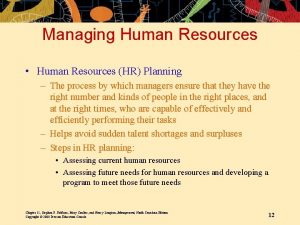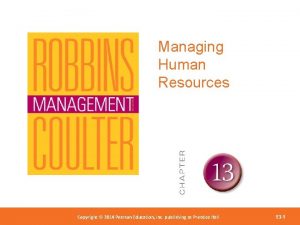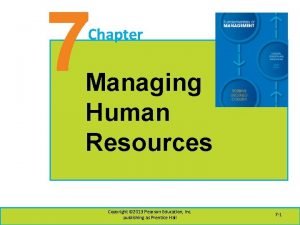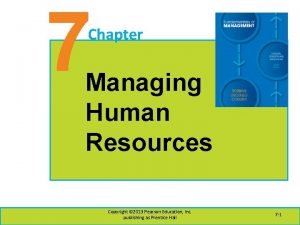2 Managing Strategic Human Resources Today Copyright 2013


















- Slides: 18

2 Managing Strategic Human Resources Today Copyright © 2013 Pearson Education, Inc. Publishing as Prentice Hall 2 -1

Learning Objectives (1) When you finish studying this chapter, you should be able to: 1. Summarize the basic equal employment opportunity laws regarding age, race, sex, national origin, religion, and handicap discrimination. 2. Explain the basic defenses against discrimination allegations. Copyright © 2013 Pearson Education, Inc. Publishing as Prentice Hall 2 -2

Learning Objectives (2) 3. Present a summary of what managers can and cannot do with respect to illegal recruitment, selection, and promotion and layoff practices. 4. Describe the Equal Employment Opportunity Commission enforcement process. 5. Explain important ways to manage diversity. Copyright © 2013 Pearson Education, Inc. Publishing as Prentice Hall 2 -3

Selected Equal Employment Opportunity Laws (1) • Background • Equal Pay Act of 1963 • Title VII of The 1964 Civil Rights Act Copyright © 2013 Pearson Education, Inc. Publishing as Prentice Hall 2 -4

Selected Equal Employment Opportunity Laws (2) • Executive Orders • Age Discrimination in Employment Act (ADEA) of 1967 • Vocational Rehabilitation Act of 1973 • Pregnancy Discrimination Act of 1978 Copyright © 2013 Pearson Education, Inc. Publishing as Prentice Hall 2 -5

Selected Equal Employment Opportunity Laws • The Equal Pay Act of 1963 (amended in 1972) made it unlawful to discriminate in pay on the basis of sex when jobs involve equal work, equivalent skills, effort, and responsibility, and are performed under similar working conditions. • Title VII of the 1964 Civil Rights Act says it is unlawful to fail, refuse to hire, discharge, or otherwise discriminate against any individual with respect to his/her compensation, terms, conditions, or privileges of employment, because of the individual’s race, color, religion, sex, or national origin. • Executive Orders by various presidents have expanded the effect of equal employment laws in federal agencies. President Johnson’s administration (1963– 1969) issued Executive Orders 11246 and 11375, requiring contractors to take affirmative action (steps taken for the purpose of eliminating the present effects of past discrimination) to ensure equal employment opportunity. • Age Discrimination in Employment Act (ADEA) of 1967 made it unlawful to discriminate against employees or applicants for employment who are between 40 and 65 years of age. • Vocational Rehabilitation Act of 1973 required employers with federal contracts over $2500 to take affirmative action for the employment of handicapped persons. • Pregnancy Discrimination Act (PDA) of 1978, an amendment to Title VII of the Civil Rights Act, broadened the definition of sex discrimination to encompass pregnancy, childbirth, or related medical conditions. It prohibits using such conditions to discriminate in hiring, promotion, suspension, discharge, or any other term or condition of employment. Copyright © 2013 Pearson Education, Inc. Publishing as Prentice Hall 2 -6

The Civil Rights Act of 1991 • What is it? • Who has the burden of proof? • Money damages • Mixed motives Copyright © 2013 Pearson Education, Inc. Publishing as Prentice Hall 2 -7

The Civil Rights Act of 1991 1. The Civil Rights Act (CRA) of 1991 places burden of proof back on employers and permits compensatory and punitive damages. 2. Burden of proof was shifted back to where it was prior to the 1980 s with the passage of CRA 1991; thus, the burden is once again on employers to show that the practice (such as a test) is required as a business necessity. For example, if a rejected applicant demonstrates that an employment practice has a disparate (or “adverse”) impact on a particular group, the employer has the burden of proving that the challenged practice is job related for the position in question. 3. Money Damages — Section 102 of CRA 1991 provides that an employee who is claiming intentional discrimination (disparate treatment) can ask for 1) compensatory damages and 2) punitive damages, if it can be shown the employer engaged in discrimination “…with malice or reckless indifference to the federally protected rights of an aggrieved individual. ” 4. Mixed Motives — CRA 1991 states: “An unlawful employment practice is established when the complaining party demonstrates that race, color, religion, sex, or national origin was a motivating factor for any employment practice, even though other factors also motivated the practice. ” Employers cannot avoid liability by proving it would have taken the same action—such as terminating someone—even without the discriminatory motive Copyright © 2013 Pearson Education, Inc. Publishing as Prentice Hall 2 -8

Illustrative Discriminatory Employment Practices In this section, we will discuss recruitment, selection standards, and promotion, transfer, and layoff procedures. Copyright © 2013 Pearson Education, Inc. Publishing as Prentice Hall 2 -9

Illustrative Discriminatory Employment Practices Pre-employment questions are not inherently legal or illegal. Rather, the impact of the questions is what courts assess in making determinations about discriminatory practice. “Problem questions” are those which screen out members of a protected group. • • What you can and cannot do Recruitment Misleading information Help wanted ads Copyright © 2013 Pearson Education, Inc. Publishing as Prentice Hall 2 -10

Illustrative Discriminatory Employment Practices 1. Recruitment — If the workforce is not truly diverse, relying on word-ofmouth to spread information about job openings can reduce the likelihood of all protected groups having equal access to job openings. However, word -of-mouth is an excellent source of quality candidates, as long as the workforce is diverse and representative of the area in which the firm recruits. It is unlawful to give false or misleading job information. Helpwanted ads should be screened for potential age and gender bias. 2. Misleading Information — It is unlawful to give false or misleading information to members of any group or to fail to advise them of work opportunities and the procedures for obtaining them. 3. Help Wanted Ads — “Help wanted—male” and “Help wanted—female” advertising classifieds are violations of laws forbidding sex discrimination in employment unless sex is a BFOQ for the job advertised. Also, you cannot advertise in any way that suggests that the employer discriminates against applicants based on age (as in “young” man or woman, unless, of course, it is a BFOQ). Copyright © 2013 Pearson Education, Inc. Publishing as Prentice Hall 2 -11

Selection Standards (1) • Educational requirements • Tests • Preference to relatives • • • Height, weight Appearance Health questions Arrest records Application forms Copyright © 2013 Pearson Education, Inc. Publishing as Prentice Hall 2 -12

Selection Standards (2) • Promotion, Transfer, and Layoff Procedures • Uniforms Copyright © 2013 Pearson Education, Inc. Publishing as Prentice Hall 2 -13

Diversity Management and Affirmative Action Programs • Diversity’s potential pros and cons • Some downsides – Stereotyping – Discrimination – Tokenism – Ethnocentrism – Gender-role stereotypes • Some diversity benefits Copyright © 2013 Pearson Education, Inc. Publishing as Prentice Hall 2 -14

Diversity Management and Affirmative Action Programs Companies today are striving for racial, ethnic, and sexual workforce balance, “not because of legal imperatives, but as a matter of enlightened economic self-interest. ” Diversity means being diverse or varied, and at work it means having a workforce comprised of two or more groups of employees with various racial, ethnic, gender, cultural, national origin, handicap, age, or religious backgrounds. Some Downsides — Demographic differences can produce behavioral barriers. a. Stereotyping — the process in which someone ascribes specific behavioral traits to individuals based on apparent membership in a group. b. Discrimination — taking specific actions toward or against the person based on the person’s group. c. Tokenism — happens when a company appoints a small group of women or minorities to high-profile positions. d. Ethnocentrism — is the tendency to view members of other social groups less favorably than one’s own. e. Gender-role stereotypes — the tendency to associate women with certain jobs. Some Diversity Benefits — The key is properly managing these threats. Diversity climate is the extent to which employees believe the firm promotes equal opportunity and inclusion. Copyright © 2013 Pearson Education, Inc. Publishing as Prentice Hall 2 -15

Equal Employment Opportunity versus Affirmative Action Copyright © 2013 Pearson Education, Inc. Publishing as Prentice Hall 2 -16

Equal Employment Opportunity versus Affirmative Action 1. Equal Employment Opportunity versus Affirmative Action — Equal employment opportunity aims to ensure that anyone, regardless of race, color, sex, religion, national origin, or age, has an equal chance for a job based on his/her qualifications. 2. Affirmative action goes beyond equal employment opportunity by requiring the employer to make an extra effort to recruit, hire, promote, and compensate those in protected groups to eliminate the present effects of past discrimination. Copyright © 2013 Pearson Education, Inc. Publishing as Prentice Hall 2 -17

Steps in an Affirmative Action Program 1. 2. 3. 4. 5. Written policy Top-management support Publicize Survey current minority and female employees Analyze HR practices 6. 7. 8. 9. Specific HR programs Focused recruitment Internal audit and reporting Develop support Copyright © 2013 Pearson Education, Inc. Publishing as Prentice Hall 2 -18
 Managing human resources in small and entrepreneurial firms
Managing human resources in small and entrepreneurial firms Managing human resources in small and entrepreneurial firms
Managing human resources in small and entrepreneurial firms Managing global human resources
Managing global human resources Managing human resources bohlander
Managing human resources bohlander Chapter 10 managing human resources
Chapter 10 managing human resources Bohlander and snell
Bohlander and snell Managing human resources in small and entrepreneurial firms
Managing human resources in small and entrepreneurial firms Managing hospitality human resources
Managing hospitality human resources Managing global human resources
Managing global human resources What are the five basic functions of the management process
What are the five basic functions of the management process Mbti personal impact report
Mbti personal impact report Today meeting or today's meeting
Today meeting or today's meeting We have class today
We have class today Proposal kickoff meeting agenda
Proposal kickoff meeting agenda Fingerprint galton details
Fingerprint galton details Today's lesson or today lesson
Today's lesson or today lesson Today's lesson or today lesson
Today's lesson or today lesson Managing data resources
Managing data resources Lpdi
Lpdi
